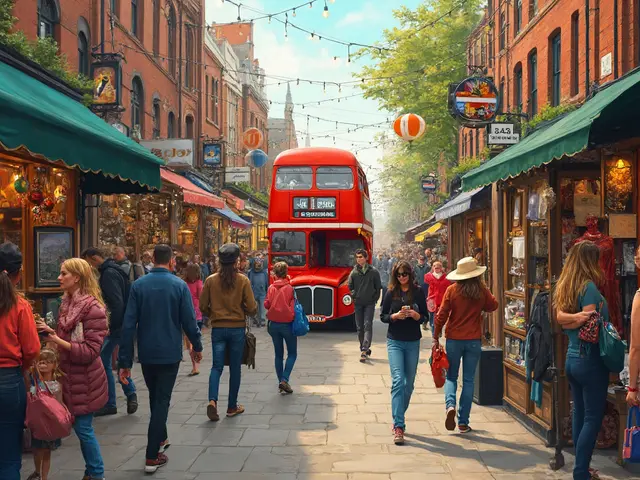If you’ve ever walked home from the West End after a late night, looked up and suddenly found the Shard cutting through London’s grey drizzle, or caught golden sunset glimmers twinkling on St Paul’s dome while crossing the Millennium Bridge, you know the *buzz* London’s iconic buildings can send through you. There’s something magnetic about these landmarks—they’re the city’s calling cards, instantly familiar even to total newcomers. It’s not just a skyline. It’s a living postcard, each structure a story and a statement, right here in the heart of this wild, ever-surprising city.
The Classics: London’s Time-Tested Icons
Start with the usual suspects, and you’ll see why London’s “greatest hits” are so beloved. The Tower of London is a fortress, palace, prison, and treasure house—sometimes all at once, depending on which century you landed in. William the Conqueror built it in the 11th century, but each era left its mark (literally: bored Beefeaters can show you the graffiti from prisoners locked in its stone walls). Think about it: this spot held Anne Boleyn (before things went south), glittered with royal jewels for centuries, and even had polar bears thanks to Henry III’s wild taste in pets.
Then there’s St Paul’s Cathedral. Sir Christopher Wren’s baroque masterpiece was practically born out of stubbornness after the Great Fire of London trashed the old version. The dome towers 111 meters over Ludgate Hill—one of Europe’s largest, and still the jewel of the City’s skyline. If you want drama, climb up to the Whispering Gallery and swap secrets; the acoustics can make whispers fly forty meters. Before you go, note the restoration after WWII: when the Blitz left half the city smoldering, St Paul’s stood resilient, a shot of hope in a rough time.
Westminster Abbey, right next door to the Houses of Parliament, is the UK’s royal HQ when it comes to coronations, weddings, and funerals. The building’s soaring Gothic arches, intricate fan vaults, and stained glass aren’t just lovely—they’re loaded with history. Nearly every monarch since 1066 was crowned here. With over 3,000 burials and memorials, you’re stepping over the final resting places of Dickens, Darwin, Newton, and a parade of poets in the Abbey’s Poet’s Corner.
Buckingham Palace is more than a tourist selfie magnet. From the Changing of the Guard parade (with its horses, snappy uniforms, and jingling brass bands) to palace open days in summer, it’s part of London’s living theatre. Tip: during Trooping the Colour in June, the Queen (or now the King) leads the royal family onto that instantly recognizable balcony, waving to crowds packing the Mall. There’s no better place to feel how tradition and spectacle blend in British culture.
And you can’t leave out the Palace of Westminster, now known most by its clock tower: Big Ben (technically, that’s the bell—but who’s arguing?). This neo-Gothic masterpiece sits beside the Thames, so you’ll spot it on any decent city river cruise. At night, the illuminated clockface floats like a ghost in the London mist—a signal you’re never too far from the city’s thumping heartbeat.
Modern Marvels: Changing the London Skyline
If the classics feel like ancient history, London’s modern buildings kick things up a gear. The Gherkin (officially 30 St Mary Axe) wasn’t always loved—when it launched in 2004, some said it looked like a fat cigar or a pickle. But now it’s as London as rainy afternoons and red buses. Designed by Norman Foster, the Gherkin is a true eco-friendly pioneer—its spiral shape means less wind resistance and it uses way less energy than most skyscrapers. If you ever get invited up (usually it’s invite-only for the offices or private events), you’re in for 360-degree views that make you feel like Bond, shaken not stirred, admiring your city from above.
The Shard, finished in 2012, is Western Europe’s tallest building. You might have spotted its spire piercing the clouds as far away as Hampstead Heath. While a pricey ticket (about £30) gets you up to the viewing platform, the best tip? Buy a £5 espresso at the Aqua Shard café on floor 31 if you just want a cheeky taste of the view. The glass splinters running up its sides aren’t just for show: architect Renzo Piano designed them to reflect the ever-changing London sky, so The Shard always looks a bit different, from dazzling sunrise to moody twilight.
London has a love affair with quirky names. The Walkie Talkie (20 Fenchurch Street) looks like a phone about to topple over, but it’s home to the Sky Garden—lush public gardens 155 meters up (and free to book, though slots disappear fast on weekends). It’s the kind of spot where City types and Instagrammers unite, chasing both cocktails and killer shots of the Thames snaking below.
The Cheesegrater (Leadenhall Building) stands just across the street, with its sharp, sloping wedge. It’s been hailed for its engineering as much as its look—the steel frame’s bright red accents are actually structural, not just fancy window dressing. Pop by on Open House London weekends, when the city flings open the doors of buildings usually off-limits. You might just get inside for a nose around the stuff hidden behind the glass.
Modern buildings aren’t only for office worker bees. The O2, known formerly and less sexily as the Millennium Dome, now buzzes with concerts, restaurants, and adrenaline junkies clambering over its roof in climbing harnesses for views of Canary Wharf—and a bit of windblown drama when the weather blows in off the river.
Hidden Gems and Local Favourites
Every Londoner knows a spot others miss. The Wilton’s Music Hall in Whitechapel is the world’s oldest surviving music hall. From the outside, it looks like a shabby, timeworn pub: from the inside, you’ll find gilded decoration, 1850s charm, and candlelit gigs that bring Victorian variety shows into the 2020s. It’s not just history for its own sake—this is somewhere you’ll find secret comedy nights, offbeat theatre, or one of those unbelievable evenings where you pinch yourself because you stumbled on something truly special.
Another overlooked marvel is Alexandra Palace. Sure, folks see it as an ice-skating spot or picnic escape, but look up next time and study the detail. There’s a Victorian TV mast—Ally Pally was where BBC first broadcast television in the 1930s. During Guy Fawkes season, you’ll find one of the city’s largest bonfires here amid crowds and mulled wine. The palace itself mixes Italianate style with giant glass windows, offering panoramic North London views.
Fitzrovia’s BT Tower used to be a spy thriller fantasy—the top-floor restaurant revolved, and only a select few could get in. Today, it’s closed to the public, but its presence slices the skyline and signals you’re in central W1. Locals joke that if you can see the BT Tower, you’re never truly lost in central London.
Brutalist fans adore the Barbican Estate, a 1970s concrete labyrinth with tropical gardens, fountains, and some of the city’s sharpest arts programming. It feels like suburban science fiction—part utopia, part maze. Bring a coffee, wander around, and see if you can find your way out again (trust me, it’s trickier than it looks).
Hampstead’s Hill Garden and Pergola is another fairytale spot. Walk a bit further from the crowded ponds, and you’ll stumble onto a crumbling, flower-choked walkway built for Edwardian high society strolls. Today, it’s popular for wedding shoots, moody selfies, and quiet reflection—especially at golden hour.
Architectural Tours, Gadgets, and Locals’ Secrets
Want a deeper dive? Dozens of guided walks run every week, from historic pub crawls in Soho (where you’ll hear about secret tunnels and ghost stories) to architecture-led tours focusing on Art Deco gems or post-war regeneration. Most kick off from central Tube stations and cost less than a couple of meal deals. Look for Open City or Blue Badge guides for off-the-wall stories and access you’d never expect.
Prefer to go solo? Grab the “London Architecture Guide” app or follow Londonist’s walking routes, which let you build a day of discoveries, taking in everything from neoclassical pillars in Somerset House to the forgotten grandeur of Battersea Power Station. The key? Always look up. Even locals get surprised by unexpected carvings, blue plaques, or bits of Roman wall poking out near modern offices.
For homegrown Londoners, Sunday afternoons mean markets and riverside meandering. Try Borough Market for some post-Southwark Cathedral eats (see its Gothic beauty rising above the stalls), or meander down to the old Bankside power station—now Tate Modern, the brick block looming with a surreal, almost alien presence. Free entry means you can wander the Turbine Hall, then chill with views across to St Paul’s.
- Want unusual? The London Mithraeum in the Bloomberg building hides a Roman temple, unearthed in the City’s foundations.
- The Seven Noses of Soho add scavenger hunt intrigue to pub crawls: these quirky artworks pop up on obscure street corners, a prank by sculptor Rick Buckley in the 1990s.
- On a drizzly Thursday, hop on the DLR and scan the horizon as you snake through Docklands—Canary Wharf’s gleaming towers put you in the future, but the odd old warehouse dockside roots you in London’s working past.
Want a stat to make you sound clever at a dinner party? London has over 20,000 listed buildings, each protected by law. The preservation vs. progress battle runs deep. The perfect example: the battle to save Smithfield Market’s Victorian halls, recently given a new lease on life as the future Museum of London.
| Building | Year Completed | Architectural Style | Claim to Fame |
|---|---|---|---|
| St Paul’s Cathedral | 1710 | Baroque | Largest cathedral dome in the UK |
| The Shard | 2012 | Neo-futurism | Tallest building in Western Europe |
| Westminster Abbey | 960 AD (rebuilt 13th century) | Gothic | Royal coronations, burials, weddings |
| The Gherkin | 2004 | Neo-futurism | Innovative eco-friendly offices |
| The Barbican | 1982 | Brutalist | Europe’s largest arts centre |
Beyond Sightseeing: How London’s Architecture Shapes City Life
It’s not all photos and fun facts. The way London’s iconic buildings are stitched into daily routines says everything about how the city works—and why it feels so different from anywhere else. For many Londoners, grand old buildings become background noise, the places they cut through on the rush to work, or the landmarks to meet friends near. The crowds flocking to Camden’s Roundhouse for gigs rarely think about its past as a Victorian engine shed. And how many folks dashing across Liverpool Street actually know about the glass-roofed Broadgate Exchange atrium, where city execs sip lattes while staring at contemporary art installations?
The old collides with the new round every corner. You’re just as likely to grab porridge beneath the flying buttresses of Southwark Cathedral (check out Hay’s Galleria for modern glass roofs and quirky shopping) as you are to work from a WeWork box inside a converted warehouse near King's Cross. That’s especially clear when you see how developers can transform ignored corners into buzzing hot spots—think Coal Drops Yard, once an industrial relic, now packed with boutiques, bars, and tech start-ups. These spaces blend gritty brickwork with cutting-edge design, proving London’s not content to freeze itself in time.
London councils and preservation groups can be fierce: the battle around the new Tulip skyscraper (proposed near the Gherkin) shows just how tricky it is to add to the skyline. People want new design, but not at the cost of soul or those famous riverside views. For every shiny new tower, there’s a local campaign demanding more green space, better public access, or genuine affordable housing. Even historic markets like Leadenhall and Spitalfields fight to stay real, balancing artisan cheese stalls with the glare of chain coffee shop signs. Everything’s in flux—which is part of London’s power.
If you’re a visitor, don’t limit yourself to the obvious photo stops. Grab a Mobike or hop a red double-decker, then lose yourself where modern glass brushes up against medieval alleys. Or join a citizen’s crowd-funded architecture tour—Londoners love showing off their city’s weirdest and best angles, so ask questions, poke your nose into that mystery doorway, and skip the obvious for the hidden gems. The city rewards curiosity.
And for locals? Try “building watching.” Bring coffee, plant yourself on the South Bank, and see how the skyline shifts minute by minute as sun, clouds, and the river play tricks with the light. It’s addictive—the sort of thing that makes random Wednesdays feel like you’re right in the middle of something bigger than yourself, living inside a city that’s always changing but always, unmistakably, London.




